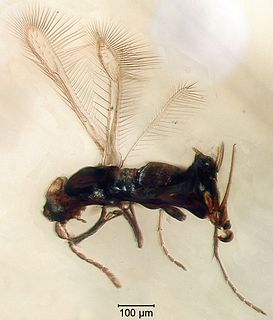 W
WAspidopleura is an extinct monotypic genus of parasitic wasp in the Eupelmidae subfamily Neanastatinae and at present, it contains the single species Aspidopleura baltica. The genus is solely known from the Early Eocene Baltic amber deposits in the Baltic Sea region of Europe.
 W
WBrevivulva is an extinct genus of parasitic wasp in the Eupelmidae subfamily Neanastatinae and contains the single species Brevivulva electroma. The genus is solely known from the Early Eocene Baltic amber deposits in the Baltic Sea region of Europe.
 W
WThe blue ant, also known as the blue-ant or bluebottle, despite its name and appearance, is not an ant, but rather a species of large, solitary, parasitic wasp sometimes known as a flower wasp. It is native to south and southeast Australia, including the states of Tasmania, New South Wales, Victoria, and South Australia. It is the sole member of the subfamily Diamminae and the genus Diamma, and is both morphologically and behaviorally unusual among members of the family Tiphiidae.
 W
WThe Australian cicada killer wasp, Exeirus lateritius, the sole member of the genus Exeirus, is a large, solitary, ground-dwelling, predatory wasp. It is related to the more common genus of cicada killers, Sphecius. In Australia, E. lateritius hunts over 200 species of cicada.
 W
WKikiki is a genus of fairyfly wasps containing a single species, Kikiki huna, known from Hawaii, Costa Rica, Nagarcoil and Trinidad. At 0.15 mm (0.0059 in), it is the smallest flying insect known as of 2019. It is a close relative of wasps in the genus Tinkerbella. It was discovered in the Hawaiian Islands by John T. Huber and John W. Beardsley, and published in 2000. The name Kikiki huna consists of two Hawaiian words that both carry the meaning 'tiny bit'.
 W
WLeptocybe invasa, the blue gum chalcid wasp or eucalyptus gall wasp, is a chalcid wasp which is the only species in the monotypic genus Leptocybe in the subfamily Tetrastichinae, of the family Eulophidae. It is a gall wasp which causes the formation of galls on a number of species of Eucalyptus, it was described in 2004 after galls were found in river red gums in the Mediterranean and Middle East and has since been found to be a widespread species where its host trees are planted. It is indigenous to Australia.
 W
WMegalara garuda, colloquially referred to as the "King of Wasps", is a large wasp and the only species in the genus Megalara, family Crabronidae, tribe Larrini. It is only known from the Mekongga Mountains in the southeastern part of the Indonesia island of Sulawesi. It was described in 2012 by Lynn Kimsey, director of the Bohart Museum of Entomology and professor of entomology at the University of California, Davis, and Michael Ohl, curator and head of entomology at the Museum für Naturkunde, Berlin. Rosichon Ubaidillah from the Indonesian Institute of Sciences also contributed the discovery.
 W
WMyanmymar is an extinct genus of fairyfly preserved in Burmese amber from Myanmar. It has only one species, Myanmymar aresconoides. It is dated to the earliest part of the Cenomanian stage of the Late Cretaceous, around 99 million years old. As of 2011, it is the oldest known fossil mymarid.
 W
WNeanaperiallus is an extinct monotypic genus of parasitic wasp in the Eupelmidae subfamily Neanastatinae containing only a single species, Neanaperiallus masneri. The genus is solely known from the Early Eocene Baltic amber deposits in the Baltic Sea region of Europe.
 W
WPalaeocimbex quadrimaculatus is a species of sawflies in the family Cimbicidae, the only species in the genus Palaeocimbex.
Protonectarina sylveirae, commonly referred to as the Brazilian wasp, is a neotropical swarm-founding wasp species that ranges widely across South America. This species relies heavily on the consumption of animal protein rather than nectar. P. sylveirae preys heavily on agricultural pests to coffee crops, keeping pest populations low.
 W
WSyntexis libocedrii, is the only living species in the wood wasp family Anaxyelidae, within the Symphyta, though the family has an extensive Mesozoic fossil record. This species is thus a "living fossil". It has the remarkable behavior of ovipositing only in recently burnt incense-cedar (Calocedrus), red cedar (Thuja) or juniper (Juniperus). The wood is often still smoldering while the wasp is laying its eggs, and the larvae develop in the wood. S. libocedrii occurs from the mountains of central California to southern British Columbia, but is very rarely seen, except by firefighters.
 W
WTinkerbella is a genus of fairy wasps, containing the single species Tinkerbella nana from Costa Rica. It is one of the smallest known flying arthropods and belongs to the family Mymaridae. The smallest flying arthropod known was Megaphragma caribea, a trichogrammatid wasp 170 micrometres long, until the discovery of the mymarid Kikiki huna, 150 micrometres long.